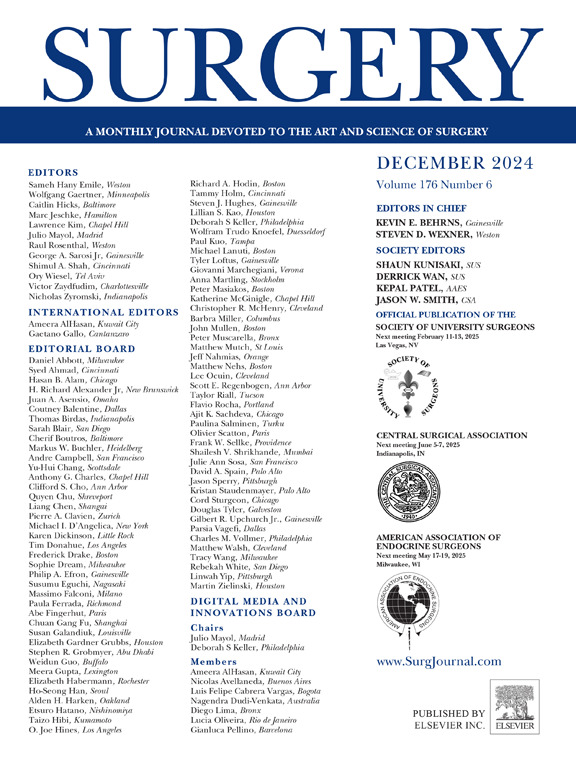The risks of inflammation and metabolism in distinct phenotypes of bicuspid aortic valve–associated aortopathy and aortic dissection: A population-based cohort study
IF 2.7
2区 医学
Q1 SURGERY
引用次数: 0
Abstract
Background
Bicuspid aortic valve is frequently associated with progressive dilation of the ascending aorta and aortic root, predisposing patients to life-threatening complications such as aortic dissection. The roles of systemic inflammation and glucose-lipid metabolism in bicuspid aortic valve–associated aortopathy remain poorly defined.
Methods
We retrospectively analyzed 1,678 bicuspid aortic valve patients diagnosed between 2008 and 2024. Imaging, echocardiographic, and peripheral blood biochemical data were collected. Principal components analysis was used to generate composite metabolic and inflammatory scores. Random forest, LASSO regression, and SHAP (SHapley Additive exPlanations) methods were used for feature selection. Logistic and Cox regression models, along with restricted cubic spline analysis and Kaplan-Meier curves, were applied to evaluate risk factors for aortic dilation and Stanford type A aortic dissection.
Results
Ascending aortic dilation (≥40 mm) was present in 66.98% of patients, and aortic root dilation in 19.79%. Both metabolic and inflammatory scores were significantly associated with ascending aortic diameter, but only the metabolic score remained independently associated with root diameter after adjustment. Triglyceride-glucose and monocyte-to-lymphocyte ratio were identified as the key metabolic and inflammatory markers. Triglyceride-glucose was independently associated with ascending aortic dilation (odds ratio = 2.15, P < .001), but not with Stanford type A aortic dissection. Monocyte-to-lymphocyte ratio was independently associated with both ascending aortic dilation (odds ratio = 3.17, P = .001) and Stanford type A aortic dissection (hazard ratio = 8.87, P < .01). A monocyte-to-lymphocyte ratio threshold of 0.38 stratified Stanford type A aortic dissection risk (log-rank P = .003). For aortic root dilation, neither the monocyte-to-lymphocyte ratio nor the triglyceride-glucose index showed significant independent associations overall. Subgroup analysis revealed that the triglyceride-glucose index was significantly associated with increased root diameter only in patients with aortic root diameter <40 mm.
Conclusions
Systemic metabolic and inflammatory states are key contributors to ascending aortic dilation, but not to aortic root dilation, in patients with bicuspid aortic valve. Monocyte-to-lymphocyte ratio is a robust predictor of Stanford type A aortic dissection, offering a potential biomarker for early risk stratification and surgical decision making. These findings support the presence of phenotype-specific mechanisms in bicuspid aortic valve–associated aortopathy and underscore the distinct roles of inflammation and metabolism in different aortopathy phenotypes.

不同表型的二尖瓣主动脉瓣相关病变和主动脉夹层的炎症和代谢风险:一项基于人群的队列研究
背景:二尖瓣主动脉瓣常与升主动脉和主动脉根部进行性扩张相关,使患者易发生危及生命的并发症,如主动脉夹层。全身炎症和糖脂代谢在二尖瓣主动脉相关病变中的作用仍不明确。方法:回顾性分析2008年至2024年间诊断的1678例二尖瓣主动脉瓣患者。收集影像学、超声心动图和外周血生化数据。主成分分析用于生成复合代谢和炎症评分。随机森林、LASSO回归和SHapley加性解释(SHapley Additive explanation)方法用于特征选择。应用Logistic和Cox回归模型、受限三次样条分析和Kaplan-Meier曲线评价主动脉扩张和Stanford A型主动脉夹层的危险因素。结果:66.98%的患者出现升主动脉扩张(≥40 mm), 19.79%的患者出现主动脉根扩张。代谢评分和炎症评分均与升主动脉直径显著相关,但调整后仅代谢评分与根直径保持独立相关。甘油三酯-葡萄糖和单核细胞-淋巴细胞比率被确定为关键的代谢和炎症标志物。甘油三酯-葡萄糖与升主动脉扩张独立相关(优势比= 2.15,P < 0.001),但与斯坦福A型主动脉夹层无关。单核细胞/淋巴细胞比值与升主动脉扩张(优势比= 3.17,P = .001)和Stanford A型主动脉夹层(风险比= 8.87,P < .01)均独立相关。单核细胞与淋巴细胞比值阈值为0.38分层Stanford A型主动脉夹层风险(log-rank P = 0.003)。对于主动脉根部扩张,单核细胞/淋巴细胞比率和甘油三酯-葡萄糖指数均未显示出显著的独立相关性。亚组分析显示,甘油三酯-葡萄糖指数仅与主动脉根直径增加相关。结论:在二尖瓣主动脉瓣患者中,全身代谢和炎症状态是升主动脉扩张的关键因素,而不是主动脉根扩张的关键因素。单核细胞与淋巴细胞比率是斯坦福a型主动脉夹层的一个强有力的预测指标,为早期风险分层和手术决策提供了一个潜在的生物标志物。这些发现支持在二尖瓣主动脉相关病变中存在表型特异性机制,并强调炎症和代谢在不同主动脉病变表型中的独特作用。
本文章由计算机程序翻译,如有差异,请以英文原文为准。
求助全文
约1分钟内获得全文
求助全文
来源期刊

Surgery
医学-外科
CiteScore
5.40
自引率
5.30%
发文量
687
审稿时长
64 days
期刊介绍:
For 66 years, Surgery has published practical, authoritative information about procedures, clinical advances, and major trends shaping general surgery. Each issue features original scientific contributions and clinical reports. Peer-reviewed articles cover topics in oncology, trauma, gastrointestinal, vascular, and transplantation surgery. The journal also publishes papers from the meetings of its sponsoring societies, the Society of University Surgeons, the Central Surgical Association, and the American Association of Endocrine Surgeons.
 求助内容:
求助内容: 应助结果提醒方式:
应助结果提醒方式:


